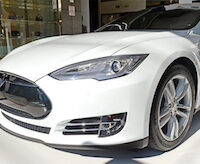Who’s at Fault When Robot Cars Crash and Injure People?

Where We Are Today
Most cars now already feature some form of self-driving technology. This includes cruise control and electronic stability control. It also includes recent innovations like automatic braking, lane departure alerts, and self-parking. The latest technologies, like Autopilot from Tesla and Drive Pilot from Mercedes-Benz, automatically steer, adjust speed, and brake. Instead of relying on eyes, ears and a brain for control, autonomous vehicles depend on data. This includes data from cameras, radar and high-tech sensors that detect light – all fed into an onboard computer.
Since we share the road with both old and new vehicles, all with a mix of technologies, the Society of Automotive Engineers created a six-level ranking system. Level Zero, One and Two vehicles still require human drivers to monitor the driving environment. Level Three, Four and Five vehicles put the computer in charge of monitoring the driving environment. Only Level Three vehicles, like the Tesla, are commercially available today. But traditional manufacturers, along with new players like Google and Uber, are testing fully autonomous Level Five vehicles. They predict these cars will be available to the public in the early 2020s.What Autonomous Vehicles Mean to You
The most encouraging prediction from the transition to driverless cars is a dramatic reduction in crashes. According to the National Highway Traffic Safety Administration (NHTSA), more than 37,000 people died in auto accidents in 2016 and millions more were injured. NHTSA estimates that 94 percent of crashes are caused by human error. Self-driving cars are never tired, distracted, or impaired. They could dramatically reduce accidents, saving 30,000 lives or more each year.
The reality, however, is that Americans will still suffer injuries and deaths from auto crashes as self-driving technology is perfected. No technology is foolproof, especially when it involves the highly complex sensors and artificial intelligence central to self-driving cars. We’ve also learned the hard way that automakers deny responsibility or cover up manufacturing defects to protect profits. And even if Level Five automation is available to the public in 2020, it will be another 15 to 20 years before all vehicles on the road have the latest self-driving technologies.
Operators Still Blamed for Crashes
According to the car crash lawyers at Manning Zimmerman & Oliveira PLLC, in a collision involving autonomous vehicles, the question of liability is murky at best. Is the operator at fault, the manufacturer, the software designer? Unfortunately, the trend has been to blame the operator. Manufacturers suggest that humans should be ready to take over when self-driving systems hand over the controls. Research shows, however, that humans are not well adapted to re-engage with complex tasks. These tasks include driving in an emergency situation, once attention has been allowed to wander.
As more and more vehicles become completely driverless, it makes less and less sense to hold their human operators liable. Instead, the car crash lawyers at Manning Zimmerman & Oliveira PLLC see strict liability as the best solution, where manufacturers take full responsibility for crashes when the robot system is driving. This same principle already applies to common carriers like bus companies, airlines, or train operators, where passengers are completely dependent on the carrier for their safety. Auto insurance as we know it today would be eliminated under this scenario. Who needs an insurance policy if they’re not driving?
In the Meantime …
Self-driving technologies and eventually fully autonomous cars will likely be a reality sooner than later. Consider these tips along the way:
-
Do your research: Cars that already have backup cameras or automatic braking are already on the road today. Before you purchase a new car, review safety ratings for both the mechanical and the computer-driven technologies already on board.
-
Stay vigilant: Just like driving a car with no automated features, keep your attention on the road. It’s tempting to believe that once self-driving cars are introduced, you can relax your focus. Don’t exclusively rely on automated features to keep you safe.
-
Support accountability: There are laws currently being written about liability and safety when it comes to driverless cars. Support the laws and lawmakers that insist on strict liability for autonomous vehicle manufacturers.
Contact Experienced New Hampshire
Car Crash Lawyers for a Free Consultation
Have you or a loved one been injured by another person’s careless acts? If so, it is essential that you have competent legal representation from the onset of your case through litigation. Big insurance companies have lawyers looking out for their interests and you should too!
For a free consultation, contact the Manchester car crash lawyers at the Law Office of Manning Zimmerman & Oliveira PLLC. We may be reached at 603-624-7200 or by email at info@MZLawNH.com. We may also be contacted by using the “contact us” or chat feature on our website.
Experienced. Knowledgeable. Personally Committed to Justice.
 We invite you to subscribe to our newsletter. You can also follow us on Twitter.
We invite you to subscribe to our newsletter. You can also follow us on Twitter.

